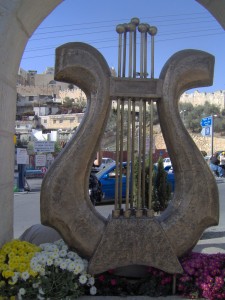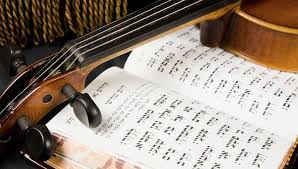In this last leg of our journey to explore the relationship of music and the major religions of the world, this brief condensation of sacred music in Judaism cannot fully explain the extent of music and its relationship with Jewish life. As with our posts on the other major religions of the world: Buddhism, Christianity, Hinduism, and Islam, these are attempts to provide an overview of each, rather than a comprehensive account. There are undoubtedly many omissions for each religion as well as content that is open for debate. Because one or two blog posts cannot accurately depict the full relationship that music holds with the world’s major religions – this has not been our attempt in this series. It aims to show how from the very beginning of recorded music, sacred and worship music has been centrally intertwined in our society as a whole. Judaism is no exception to this.
Early Written Records of Music and Judaism
From the very beginning of biblical times, music has been seen as a integral part of Jewish life. At the very recorded moment of Israel’s birth as a nation, Exodus tells that Moses led the people of Israel in a song of divine praise. It is said that Jewish music stems from prayer chants of the Levant and influences the musical notation in the bible that is still practiced today. The bible goes on to describe the use of many different instruments as a part of synagogal music in the ancient Temple in Jerusalem. According to the Mishnah, the first major written collection of Jewish oral traditions, the regular Temple orchestra consisted of a choir of twelve singers, as well as an orchestra of twelve instruments including a harp (Nevel), lyre (the Knnor), ram’s horn (Shofar), trumpet (chatzultzera), small drum (tof), cymbal (metziltayim) bell (paamon) and flute (halil).
After the destruction of the Temple, a consensus developed in Judaism that all music and singing would be banned, although this custom was soon understood that only as a ban outside of religious services. Within the synagogue, the custom of singing soon re-emerged, often in the mode of singing prayers. Known as hazzanut, or “the art of being a hazzan (cantor),” this tradition was introduced into the liturgy as passages that were regarded as to demand special vocalization.

The Three Areas of Sacred Jewish Music
While Jewish music has its roots in the Middle East, its traditions are not limited to any geographical area. Just as history tells how Jewish society was one of “wanderers,” sacred music came from many influences from those outside of Israel or Dispora. This cross-cultural phenomenon gave birth to many different sub-genres within sacred Jewish music, but three main areas have been categorized – Ashkenazic, Sephardic, and Mizrahi. Music of the Ashkenazim was very popular with European Jews. Klezmer, its most popular form, was performed by traveling musicians who would entertain villages with folk dances and traditional songs sung in Yiddish. Sephardic music, sung in ancient Spanish origin, contains some of the melodies and rhythms of Mediterranean regions while Mizrahi from the Jewish communities of North Africa and Arab countries often contains Arabic lyrics. As a result of these many cross-cultural and geographic differences, religious as well as secular Jewish music is a blend of many different languages and styles.
Secular and Modern Sacred Jewish Music
Jewish music encompasses many genres of religious, semi religious, and folk music used in the synagogue and in the Jewish home as well as classical music using Jewish texts or themes. Jewish music today includes a wide diversity of musical traditions and Jewish songs sung in many different languages. There seems to have been a polarization over the last few generations between the Orthodoxy and Reform Judaism, with each treating its sacred music differently. Increasingly, Jewish musicians produce work with noticeably external, modern influences influenced by a new generation. North American Jewish music, for example, reflects a delicate attempt to uphold distinct Jewish identity while participating in the broader North American culture.

The rise of North American Jewish folk music, as well as the revival of traditional music such as klezmer, is a testament to this phenomenon. Indeed, many of North Americas most famous composers and songwriters are Jewish, including Aaron Copeland, George Gershwin, Irving Berlin, Carole King, and Bob Dylan. The scope of contemporary Jewish music embraces a wide range of genres and styles, including music for the synagogue, folk and popular music on religious themes, modern creations based on traditional musical styles and languages, and classical music. Every sector of the Jewish community – from orthodox to secular – participates in the Jewish music endeavor, creating, performing, and listening to the particular music that meets its taste and needs.
As we have explored the strong and reciprocal relationship between the major religions of the world and music, one common theme has emerged across all. Music in Buddhism, Christianity, Hinduism, Islam, and Judaism have each been influenced not only by the sacred scriptures and texts they adhere to, but also the geographical and cultural influences each has adopted over time.





